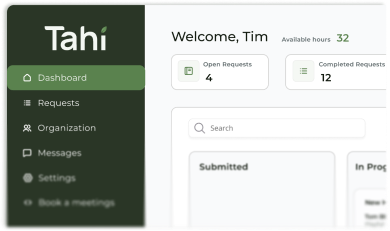Scalable Web Design
Scalable web design is the practice of creating a website that can grow and adapt alongside your business, handling increased traffic and new features without a complete rebuild.
What does it mean for a website to be scalable?
When we talk about a scalable website, we're talking about more than just its ability to handle a sudden surge in traffic. True scalability is about building a digital asset that is ready for the future. It's a website designed and built from the ground up to accommodate growth in every direction, whether that means adding hundreds of blog posts, new product lines, complex features like a customer portal, or integrating with new marketing tools.
Think of it like building a house. A non-scalable website is like a perfectly finished tiny home. It's great for now, but adding a new bedroom is a major, disruptive renovation. A scalable website is like a house built on a strong foundation with a master plan that anticipates future extensions. You can add a new wing or even a second story without having to tear the whole structure down and start again. It's about strategic foresight, not just immediate needs.
How does Webflow support scalable web design?
Webflow is an exceptional platform for creating scalable websites, which is why it's our core tool at Tahi Studio. One of its most powerful features is the Webflow CMS (Content Management System). It allows us to build flexible collections for anything you can imagine, from blog posts and team members to case studies and services. This empowers your team to add and manage vast amounts of content easily, ensuring your site can grow without constant developer intervention.
Beyond the CMS, Webflow's technical foundation is built for scale. It produces clean, semantic code that provides a robust structure for search engines and future development. Its hosting is fast, secure, and managed by Amazon Web Services (AWS), meaning it can handle significant traffic spikes without breaking a sweat. Furthermore, its ability to integrate with thousands of other applications through APIs means that as your business needs new functionality, your website can evolve to include it seamlessly as part of your broader digital ecosystem.
What are the key elements of a scalable design in Figma?
Scalable design begins long before a single line of code is written. It starts in the design phase, typically within Figma. The cornerstone of a scalable design is a comprehensive Design System. Instead of designing static, one-off pages, we create a system of reusable components, defined styles for colours and typography, and consistent spacing rules.
When we create a button, a form field, or a navigation bar, we build it as a flexible component that can be reused across the entire site through component-based design principles. This means when your business is ready to launch a new service or feature, we aren't starting from a blank canvas. We are assembling new pages from a pre-approved, consistent library of digital building blocks. This approach dramatically speeds up the design and development process for future expansions and, crucially, maintains perfect brand consistency as your website grows.
What are the risks of not having a scalable website?
Investing in a website that isn't scalable is one of the most common and costly mistakes a growing business can make. The most significant risk is the inevitability of a complete, expensive, and time-consuming rebuild. When your business strategy evolves or your traffic grows, a non-scalable site will hit a wall, forcing you to start from scratch. This not only halts your digital momentum but also represents a major, often unplanned, capital expense laden with technical debt.
Beyond the financial cost, a lack of scalability leads to a deteriorating user experience. As you try to bolt on new features or add content to a site not designed for it, things start to break. Pages load slowly, navigation becomes confusing, and the overall look and feel becomes inconsistent. This creates frustration for your visitors, harms your brand credibility, and can negatively impact your search engine rankings through poor page speed performance, ultimately stifling the very growth you're trying to achieve.
How can a partnership approach ensure my website remains scalable?
Building a scalable foundation is the first step, but scalability is not a 'set and forget' task. It's an ongoing strategy. Your business goals will change, new technologies will emerge, and customer expectations will evolve. A one-off website project might address today's needs, but it can't anticipate the specific challenges and opportunities of tomorrow, leaving you to manage its evolution alone.
Working with a dedicated design and development partner changes this dynamic completely. An ongoing partnership allows for continuous, iterative improvements to your site. Instead of waiting for a crisis that forces a rebuild, a partner can help you proactively plan for growth, strategically implement new features, and ensure your digital platform is always optimised for your current business objectives. Through our subscription model and transparent processes, this collaborative approach transforms your website from a static expense into a living, high-performing asset that grows right alongside your business.






